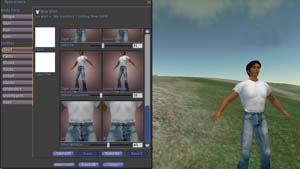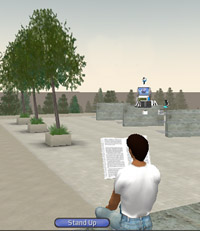
Henry Jenkins gives a fascinating account of an ongoing controversy occurring in a MMORPG in the People’s Republic of China, the fastest growing market for these online games. Operated by Netease, Fantasy Westward Journey (FWJ) has 22 million users, with an average of over 400,000 concurrent players. Last month, game administrators locked down the account of an extremely high ranking character, for having an anti-Japanese name, as well as leading a 700 member guild with a similarly offensive name. The character would be “jailed” and his guild would be dissolved unless he changed his character and guild’s name. The player didn’t back down and went public with accusations of ulterior motives by Netease. Rumors flew across FWJ about its purchase by a Japanese firm which was dictating policy decisions. A few days late, an alarming protest of nationalism broke out, consisting of 80,000 players on one of the gaming servers, which was 4 times the typical number of players on a server.
The ongoing incidents are important for several reasons. One is that it is another demonstration of how people (from any nation) bring their conceptualization of the real world into the virtual space. Sino-Japanese relations are historically tense. Particularly, memories of war and occupation by the Japan during World War II are still fresh and volatile in the PRC. In a society whose current calender year is 4703, the passage of seventy years accounts for a relatively short amount of time. Here, political and racial sentinment seamlessly interweave between the real and the virtual. However, these spaces and the servers which house them are privately owned.
The second point is that concentrations of economic and cultural production is being redistributed across the globe. The points where the real and the virtual worlds become porous are likewise spreading to places throughout Asia. Therefore, coverage of these events outside of Asia should not be considered fringe, but I see important incentives to track, report and discuss these events as I would local and regional phenomenon.
Category Archives: virtual
letters from second life

Last week, Bob mentioned that Larry Lessig, law profressor and intellectual property scholar, was being interviewed in Second Life, the virtual world created by Linden Lab. Having heard a lot of Second Life before, I was pleased to have a reason and opportunity to create an account and explore it. Basically I quickly learned that it’s Metaverse, as described in Neil Stephenson’s Snowcrash, in operation today, and I’m now a part of it too.
I already covered the actual interview. Here are a few observations from my introduction to SL.
Second Life is a humbling place, especially for beginners. Everything ,even the simplest things, must be relearned. It took me 5 minutes to learn how to sit down, another 5 minutes to read something, and on and on. Traveling to the site of Lessig event was an even more daunting task. I was given the location of this event, a name and coordinates, without any idea of what to do with them. Second Life is a vast space, and it wasn’t clear to me how to get from one point to another. I had no idea how to travel in SL, and had to ask around someone.
I presume it is evident that I’m very new to SL, by my constant trampling over people and inanimate objects. So, I continue walking into trees and rocks until I come across someone whose title contains “Mentor,” and figure that this is a good person to ask for help. Not knowing how to strike up a private conversation, I start talking out loud, not even sure if anyone is even going to pay attention.
(I will come to learn that you travel from place to place via teleportation.)
“Hi.”
“Hi Harold.”
I am relieved to discover that people are basically nice in SL, maybe even nicer than in New York. This fellow avatar is happy to chat and answer questions. Second List has a feature called “Friends” which operates like Buddies in Instant Messaging. However, I’m not sure what the social protocol for making friends is, so I make no assumptions. As I was typing “can we be friends?” I sigh with the realization that I am, in fact, back in fourth grade.
 People around me have much more sophisticated outfits than I do. So, I try out the free clothing features. I darken my pants to a deep blue and my shoes black. Then, my default shirt gets turned into a loose white t-shirt. Somehow I end up a bit like a GAP model crossed with Max Headroom. After making my first “friend,” another complete stranger comes up to me and just starts giving me clothes. Apparently, my clothes still need a little work. I try on the cowboy boots and faded jeans. Happy that I’ve moved beyond the standard issue clothes, I thank my benefactor and begin to make my way to the event.
People around me have much more sophisticated outfits than I do. So, I try out the free clothing features. I darken my pants to a deep blue and my shoes black. Then, my default shirt gets turned into a loose white t-shirt. Somehow I end up a bit like a GAP model crossed with Max Headroom. After making my first “friend,” another complete stranger comes up to me and just starts giving me clothes. Apparently, my clothes still need a little work. I try on the cowboy boots and faded jeans. Happy that I’ve moved beyond the standard issue clothes, I thank my benefactor and begin to make my way to the event.
The builders of Second Life force people to rely on other people within the virtual world. However, assistance in the real world certainly helps too. Entering Second Life, the feeling of displacement is quite clear, as if I arrived to a new city in the real world with a single address, where I don’t know anyone or how to navigate the city. The virtual world often mimics the real world, but my surprise each time I learn this fact is still ongoing. It definitely helps to know people, both in where to go that’s interesting and how to do things.
After teleporting to the event, I found myself around people who had common interests, which was great and similar to attending a lecture in the real world. At different times, I struck up a conversation with an avatar who is a publisher on the West Coast and then talked to an academic who runs a media center. In both cases, I was talking to the person literally “next” to me.
When I first heard about the interview, I learned at there was limited spacing. Which seemed strange to me, as it was taking place in a viritual space. When I arrived at the event place, I saw the ampitheater with video screens, that would show a live web stream of Lessig. The limited seating made more sense, seeing the seat of the theater. I also believe that the SL servers also have a finite capacity for the number of people to be located within a small area, because movement was jerky around concentrated groups of people. I guess I’ll have to wait for the Second Life Woodstock.
The space was crowded with people walking around, chatting, and getting up their free digital copy of Lessig’s book, “Free Culture.” (I’ve included a picture of me reading Free Culture in Second Life. You can actually read the text.)  The interview is about to begin, as an avatar with large red wings walks by me. I say out loud, “I know she was going to sit in front of me.” Adding, “Just kidding,” in case I might be offending someone, who knows who this person could be. Fortunately, she found a seat outside my sight line without incident, and the introductory remarks began.
The interview is about to begin, as an avatar with large red wings walks by me. I say out loud, “I know she was going to sit in front of me.” Adding, “Just kidding,” in case I might be offending someone, who knows who this person could be. Fortunately, she found a seat outside my sight line without incident, and the introductory remarks began.
There was a strange duality where I had to both learn what was being said, but also how to navigate the environment of a lecture as well. The interview proceeds within the social norms of a lecture. People are mostly quiet, clap and for the moderator runs the question and answer session. Afterwards, I line up to get Lessig to “sign” my virtual book at the virtual booksigning, as in my virtual public event. I finally stumble my way through the line, all the while asking many question on what I’m supposed to do. With my signed book in hand, I look at the sky, which is quite dark. I log out and return to the real world.
end of cyberspace
The End of Cyberspace is a brand-new blog by Alex Soojung-Kim Pang, former academic editor and print-to-digital overseer at Encyclopedia Britannica, and currently a research director at the Institute for the Future (no relation). Pang has been toying with this idea of the end of cyberspace for several years now, but just last week he set up this blog as “a public research notebook” where he can begin working through things more systematically. To what precise end, I’m not certain.
The end of cyberspace refers to the the blurring, or outright erasure, of the line between the virtual and the actual world. With the proliferation of mobile devices that are always online, along with increasingly sophisticated social software and “Web 2.0” applications, we are moving steadily away from a conception of the virtual — of cyberspace — as a place one accesses exclusively through a computer console. Pang explains:
Our experience of interacting with digital information is changing. We’re moving to a world in which we (or objects acting on our behalf) are online all the time, everywhere.
Designers and computer scientists are also trying hard to create a new generation of devices and interfaces that don’t monopolize our attention, but ride on the edges of our awareness. We’ll no longer have to choose between cyberspace and the world; we’ll constantly access the first while being fully part of the second.
Because of this, the idea of cyberspace as separate from the real world will collapse.
If the future of the book, defined broadly, is about the book in the context of the network, then certainly we must examine how the network exists in relation to the world, and on what terms we engage with it. I’m not sure cyberspace has ever really been a home for the book, but it has, in a very short time, totally altered the way we read. Now, gradually, we return to the world. But changed. This could get interesting.
